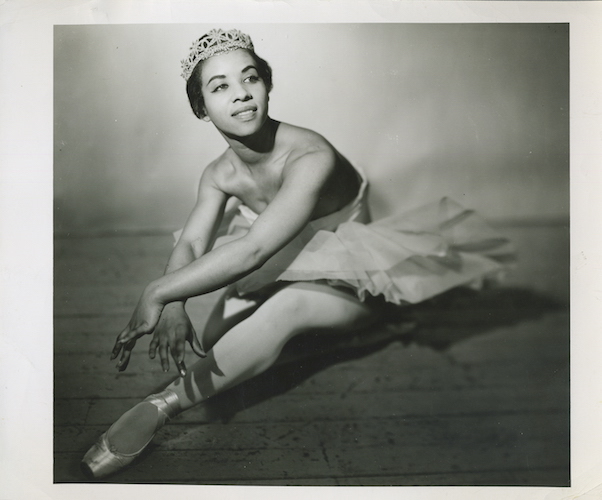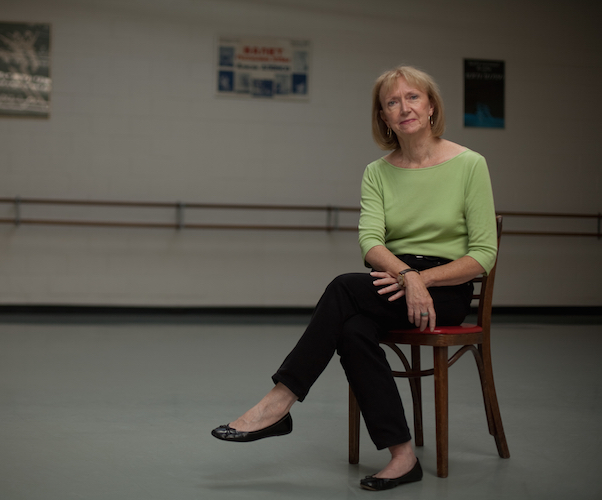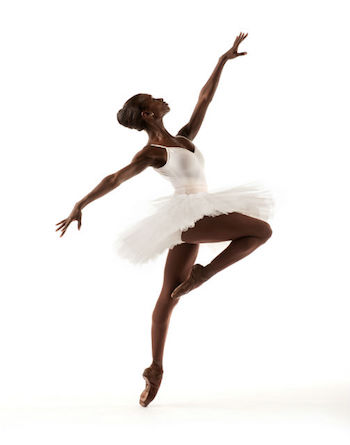Dance Preview: “Black Ballerina” — Sparking Conversations about Dance and Race
“Tokenism also plays into this issue. Some companies are hiring one dancer of color and they think they’ve done diversity.”

Dancer Delores Browne, one of the subjects profiled in “Black Ballerina.” Photo: courtesy of “Black Ballerina.”
By Janine Parker
Black Ballerina, a new documentary addressing the relative lack of diversity in many American ballet companies, will air on WGBH Saturday, October 22 at noon and 9 p.m. Produced by the non-profit company Shirley Road Productions, the film features the stories of seven African American women who are at various stages in their careers. Bianca Fabré is a student who aspires to be a professional dancer; Joan Myers Brown is the founding director of the contemporary dance group Philadanco; Delores Browne is a former dancer who performed with the short-lived American Negro Ballet and has been teaching ballet for decades; Virginia Johnson is a former principal dancer with Dance Theatre of Harlem, the company she now heads as artistic director; Ashley Murphy, a former dancer with Dance Theatre of Harlem, now dances with The Washington Ballet; Amanda Smith performs with the Charlotte [North Carolina] Ballet, and Raven Wilkinson is a retired dancer who danced and toured with the famed Ballet Russe de Monte Carlo, the first African American to do so.
Offering their take on the issue are Jean-Pierre Bonnefoux, the current artistic director of Charlotte Ballet and Roy Kaiser, artistic director emeritus of Pennsylvania Ballet. I corresponded via e-mail with Black Ballerina‘s producer and director Frances McElroy about the issues raised by the film and if she feels that the imbalance will be redressed.
Arts Fuse: In addition to Black Ballerina, you’ve made another documentary about ballet, Mirror Dance. In another interview you said you’ve always been drawn to ballet. What’s your experience with the art form?
Frances McElroy: I’ve loved ballet since being introduced to it as a 6-year old here in Philadelphia. My mother and aunt took my sister and me to see the visiting European companies. I began ballet class around the same time and studied until I entered high school. I resumed adult classes in 2000 when I began working on Mirror Dance.
AF: I understand that prior to settling on the broader-yet-specific topic of black females in American ballet companies, you originally had planned on making a documentary solely about Joan Myers Brown. Once you realized you wanted to indeed keep Joan but also branch out, how did you settle on the dancers you featured?
McElroy: I sensed that Joan Myers Brown was more interested in a film about the issues she cares so passionately about, than a film exclusively about her. She suggested I talk with Delores Browne and Raven Wilkinson. Dr. Joselli Deans, our project consultant from the beginning, was also enormously helpful in suggesting people. Joselli was a former member of Dance Theatre of Harlem and knows the subject well.
AF: Were there dancers you reached out to but in the end couldn’t include them, either because of time constraints, editing/flow considerations, or because they weren’t available or interested?

Frances McElroy, director and producer of “Black Ballerina.” Photo: courtesy of “Black Ballerina.”
McElroy: Lauren Anderson’s name came up often. I contacted the Houston Ballet and the company was very interested in participating. However, budget constraints prevented us from traveling to Houston. The company very graciously made available to us some great footage of Ms. Anderson performing in Firebird. In the documentary, Raven Wilkinson cites Lauren Anderson’s important ground breaking role in ballet.
Another constraint was the PBS broadcast length. We had many more potential characters to interview but there are only so many characters you can develop in a 53 minute time limit. It’s a constant source of frustration, but I wanted the documentary on PBS since it would be seen by a very large number of viewers — for free. Also, too many characters make it difficult to maintain focus and narrative structure. It was also suggested that we do a story from the West coast — Lines Ballet, San Francisco Ballet — but our limited budget prevented us from pursuing this.
AF: Including a student who aspires to be a professional but hasn’t attained the goal yet is a great idea, but I’m particularly curious in how you went about finding Bianca — did you get advice from one of your featured artists/directors/teachers?
McElroy: Philadanco’s assistant artistic director, Kim Bears-Bailey, also teaches ballet at the University of the Arts here in Philadelphia. She suggested we contact her student Bianca Fabré. After meeting Bianca, it became clear that she loved ballet, but perhaps never had the resources to pursue first-rate training. In the film, she represents all the young lovers of ballet — of all colors — who dream of careers but don’t have either the resources and/or the great talent required. Virginia Johnson says in the film that nine out of ten students won’t make it regardless of skin color. Bianca’s story also reflects the racism that existed in her ballet school (in Georgia) not so very long ago. Bianca warmly and openly shared her story. She is the character most mentioned by viewers. Perhaps many identify with her.
AF: I’m also curious about the two “outliers,” Jean-Pierre Bonnefoux and Roy Kaiser. Did you choose them for what you knew about them as directors or did you choose them because of what you see in their companies in terms of diversity? Did you specifically want white voices in the conversation?
McElroy: I thought it was important to have the voice of a ballet company director. Being from Philadelphia, I was of course quite familiar with The Pennsylvania Ballet where Roy Kaiser was (at the time) artistic director. It seemed logical to me to focus on our own regional company, particularly since it is a well regarded company rooted in tradition. Currently, the company has one dancer of color — a male. (Under new leadership—Angel Corella — the company is diversifying in terms of more Latin/Hispanic dancers).

Ashley Murphy of the Dance Theatre of Harlem. Photo: Rachel Neville.
At a Dance USA conference, held in Philadelphia, I met the then community outreach director of the Charlotte Ballet. She told me about Amanda Smith and how Jean-Pierre Bonnefoux hired her for her spirit, talent, and difference. So, I contacted Jean-Pierre and visited the company prior to our shoot in North Carolina. Here is a small company—in the American South, run by a Frenchman — who has assembled a small but diverse group of dancers. The company’s relationship with Dance Theatre of Harlem provided us with the material to create one of the more touching scenes in the film about exposing under-resourced youngsters to ballet. The Charlotte story seems to illustrate that breaking barriers can be done, if leadership wants to. Jean-Pierre says “you can’t just complain about it. You need to be pro-active.”
AF: Following up on that, since your film centers on female dancers, rather than male or both, did you also specifically want to include a few male voices in the conversation? Naturally, there is a limit to how broad a topic can be before it becomes weakened, but I wonder if you always knew you’d just focus on black female ballet dancers, or if you ever toyed with the idea of including black male ballet dancers as well?
McElroy: Due to time and the need to create a strong structure, I pretty much wanted to approach the topic from the female perspective. And the women we ended up interviewing were such strong storytellers … Including the male perspective would have required a much longer piece and/or a very different structure and storyline.
AF: Over the course of your research, I assume you learned a good deal about the serious outreach programs — that offer, beyond “one-off” lecture demonstrations, free tuition for underserved children who exhibit interest and potential — that many of the U.S.’s ballet company schools have. What do you think of those programs in terms of the future of diversity in ballet companies? Along those lines, would you comment on the negative effects arts funding cuts in public schools have had on children’s exposure to dance?
McElroy: I am aware of many outreach programs (i.e. Charlotte Ballet’s collaboration with DTH) and think they are great — as long as they enable youngsters to participate who lack exposure and the resources to study. Such programs are valuable as long as the available funds are used for the outreach activities and not just ways to attract funds to the companies themselves. There has to be a real desire to do this and to create change.The ballet academy I’m involved with (PA Academy of Ballet) often does “one-off” lecture demonstrations for underprivileged school children in their schools. Such programs are tremendously successful in providing exposure. The youngsters are on the edge of their seats and ask truly interesting follow-up questions. The vast majority of these youngsters have never seen ballet and PAB’s programs feature young dancers not much older than the audiences for whom they perform.
The key to these programs in my opinion is to actively go out to reach potential youngsters and not to wait for them to come to the companies. As Jean-Pierre says in the film, “you can’t just complain about it.” Just having the program isn’t enough. There needs to be active, serious outreach … Cuts in arts funding are devastating—not just to ballet. There’s money for so many other programs and there’s also so much waste in various programs. Yet, arts funding is often the first to go despite findings that the arts make valuable, long lasting contributions to the lives of youngsters. Interestingly, both Delores Browne and Joan Myers Brown were both in Ballet Club at their middle schools (back in the 40s). Times have clearly changed, but those experiences created in those two women a lasting love for ballet, rich careers in dance and a willingness to be strong advocates for the art form. Exposing youngsters to the arts helps build future audiences.
AF: The work that is being done by such programs in the ballet academies aside, one of the most compelling and poignant themes that your film underscores is the lack of exposure, the underwhelming number of examples young ballet dancers of color have up on the professional ballet stages. If you don’t see “yourself” up on stage, how do you know to have the dream to be up there? Would you talk about this?
McElroy: I totally agree with this. It’s important to involve young dancers as part of the outreach so as to inspire the youngsters watching. Ideally, these young “instructors” should reflect today’s diversity. The experience is clearly better for young audiences when the performers are of color in addition to comparable age level. FYI, at PAB, the young dancers (all white) enjoy their encounters with school children as much as the youngsters in the audience. It’s as meaningful for the dancers as for the audience members. It’s a two way street; it helps to break down barriers and stereotypes.

Amanda Smith (in pink), dancing with the Charlotte Ballet. Photo: courtesy of Janine Parker.
AF: In terms of the issue of diversity in ballet companies, there are accusations of colorism in the ballet world — that even among the black ballet dancers who make it into a company, they tend to be lighter skinned. Did that come up in any of your conversations with your subjects? If so, would you share some of their takes on the topic?
McElroy: It came up with Raven Wilkinson who is very light skinned. She wasn’t readily identified as African American while with the Ballet Russe. While on tour in the South, however, she was identified as African American by a hotel employee who was black. This resulted in Raven’s returning to New York City in the middle of the tour. Joan Myers Brown also addresses this in the film, saying that if a company takes a female dancer of color, “she has to be so fair.” This is opposed to some companies’ more readily hiring “an exotic looking black male.” Off-camera, during the four years of production, I heard comments that Misty Copeland’s success is partly due to her light skin.
AF: What else did you hear or learn that shocked you? Do you think the current state of affairs is “just” because we are still recovering from a century-plus of racism and discrimination, or did you hear anything that made you think that there are some companies that are actively — if furtively — upholding racist policies about hiring and casting?
McElroy: Bianca’s costume story kind of shocked me. [In the film, Bianca, the student, relates an incident from when she was younger: a fellow dancer (who is white) refused to wear the same costume that Bianca had worn in a production of The Nutcracker.] Joan Myers Brown also told me of a quite crude comment about her as a youngster performing in a ballet recital. (I won’t repeat it.)…
The hope of 2008 and the notion of a “post-racial” society seems, sadly and disturbingly, to have faltered particularly of late. I believe it’s more important than ever for people of different races, ethnicities, cultures and backgrounds to find ways to talk with one another. We are actively engaged in outreach with Black Ballerina in hopes of encouraging such conversations among varieties of people — through the arts. Virginia Johnson says in the film that we are all alike as humans. We need to talk with each other. Tokenism also plays into this issue. Some companies are hiring one dancer of color and they think they’ve done diversity.
AF: Some of us worry that ballet’s very existence is at stake if this great imbalance/injustice isn’t corrected. Indeed, in your film, Jean-Pierre Bonnefoux talks about this with a disquieting mixture of concern and matter-of-factness. So, what about you: are you optimistic?
McElroy: I’m optimistic when someone of Jean Pierre’s stature makes this kind of statement and chooses to run his company the way he does. [In the film, Bonnefoux, who is stepping down at the end of the 2016/2017 season, explains that he pledged to Virginia Johnson that he would take a couple of dancers from the DTH school into Charlotte Ballet’s junior ensemble each year.] To me, it seems fairly obvious, from an economic perspective, that what Jean-Pierre says is right. (Delores also touches on this point.) I’ve heard that American Ballet Theatre audiences are larger when Misty Copeland dances. But these new audiences might only come to performances where the few dancers of color perform. Will this be enough to sustain companies? Are other companies paying attention?
Regarding optimism. At least people are more aware of the subject and, hopefully, thinking more about issues of diversity, in general. There seems to be much more discussion in the past couple of years via the media. Hopefully Black Ballerina will help raise more awareness. Community outreach — which is a big part of our project — is vital as a way to stimulate discussion about this issue as it relates to ballet and other aspects of our society. I believe there needs to be a real effort for all of us to do more of this.
Janine Parker can be reached at parkerzab@hotmail.com.
Tagged: Amanda Smith, Ashley Murphy, Bianca Fabré, Black Ballerina, Charlotte Ballet, Dance Theatre of Harlem, Delores Browne, Frances McElroy, Janine Parker, Jean-Pierre Bonnefou, Joan Myers Brown, PBS, Pennsylvania Ballet, Philadanco, Raven Wilkinson, Roy Kaiser, Shirley Road Productions
